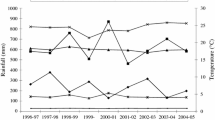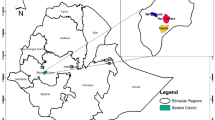Abstract
To reduce severe soil degradation associated with agriculture an intensified land-use system is being promoted in West African countries. Most soils of the West African savanna zones are so poor that the efficiency of mineral fertilizers, if applied, is very low. For this reason and because of their high cost and unavailability, many small-scale farmers are reluctant to apply fertilizer. This work investigates a fertilizer management strategy using integrated soil fertility management with a leguminous cover crop (mucuna) so as to improve the soil fertility and increase the use efficiency of fertilizer. The experiment was conducted in the coastal savanna of Togo at Djaka Kopé. The aim was to evaluate the effectiveness of mucuna short fallow (MSF) in increasing maize grain yield through an improved use efficiency of mineral fertilizer. A 2-year maize–mucuna relay intercropping system was compared with continuous sole maize cropping. Fertilizer treatments were factorial combinations of 0, 50 and 100 kg nitrogen (N) ha–1 and 0, 20 and 40 kg phosphorus (P) ha–1. While maize grain yield was significantly increased by N fertilization, P did not show any important effect on grain yield. With no N and P applied, grain yield after MSF was on average 40% (572 kg ha–1) higher than without. The response to N was much greater than the response to MSF, indicating that N was undoubtedly the key element for maize yield building. P fertilization and MSF together positively influenced the apparent N recovery fraction (NRF). N uptake alone did not reflect on its own the yield obtained, and the relationship between grain yield and N uptake is shifted by MSF, with the grain yield increase per unit of N uptake being higher with than without MSF. Combining MSF and P fertilization may therefore lead to improved N use efficiency, making the application of fertilizer N (lower rates) more attractive to small-scale farmers.
Similar content being viewed by others
References
Becker M. and Johnson D.E. 1998. The role of legume fallows in intensified upland rice-based cropping systems in West Africa. Nutr. Cycl. Agroecosyst. 53: 71–81.
Badlock J.O., Higgs R.L., Paulson W.H., Jackobs J.A. and Shrader W.D. 1981. Legume and mineral N effects on crop yields in several crop sequences in the Upper Mississippi Valley. Agron. J. 73: 885–890.
Blair J.G. and Boland O.W. 1978. The release of P from plant material added to soil. Austr. J. Soil. Res. 16: 101–111.
Breman H. 1998. Soil fertility improvement in Africa, a tool or a by-product of sustainable production? African Fertilizer Market. Special Issue on soil fertility Vol. 11. Monthly Bulletin of the International Institute for Soil Fertility Management-Africa (IFDC-A).
Carsky R.J., Tarawali S.A., Becker M., Chikoye D., Tian G. and Sanginga N. 1998. Mucuna-herbaceous cover legume with potential for multiple uses. Resource and Crop Management Research Monograph 25. IITA, Ibadan, Nigeria.
Carsky R.J., Oyewole B. and Tian G. 1999. Integrated soil management for the savanna zone of West Africa: legume rotation and fertilizer N. Nutr. Cycl. Agroecosyst. 55: 95–105.
Christianson C.B., Bationo A., Henao J. and Vlek P.L.G. 1990. Fate and efficiency of N fertilizers applied to pearl millet in Niger. Plant Soil 125: 221–231.
Ehlers W. 1996. DeWasser in Boden und Pflanzen. Dynamik des Wasserhaushalts als Grundlage von Pflanzenwachstum und Ertrag. Eugen Ulmer Verlag, Stuttgart, Germany, pp. 171–178.
Elemon K.A. 1993. —Maize (Zea maysL.) agronomy research in the Nigerian savanna. In: Fakorede M.A.B., Alofe C.O. and Kim S.K. (eds), Maize: Improvement, Production, and Utilization in Nigeria. Maize Association of Nigeria, Ibadan, Nigeria, pp. 105–117.
FAO 1991. World soil resources: an explanatory note on the FAO world soil resources map at 1:25 000 000 Scale. Food and Agriculture Organization of the United Nations, Rome, Italy, 58 pp.
Fischer M. and Wortmann C.S. 1997. Green manure research in Eastern Africa-A participatory approach. Poster presentation at the International Symposium on the Science and Practice of Short-term Improved Fallows in Humid and Subhumid Tropics, Lilongwe, Malawi.
Fujii Y., Shibuya T. and Yasuda T. 1992. Allelopathy of velvetbean: its discrimination and identification of L-DOPA as a candidate of allelopathic substances. Jpn. Agric. Res. Quart. 25: 238–247.
Giller K.E. and Wilson K.J. 1991. Nitrogen Fixation in Tropical Cropping Systems. CAB International, Wallingford, UK, 313 pp.
Gomez K.A and Gomez A.A. 1984. Statistical Procedures for Agricultural Research. An International Rice Research Institute Book. John Wiley, Brisbane, Australia, pp. 187–233.
Hulugalle N.R, Lal R. and Ter Kuile C.H.H. 1986. Amelioration of soil physical properties by Mucunaafter mechanized land clearing of a tropical rain forest. Soil Sci. 141: 219–224.
Institut Togolais de Recherche Agronomique (ITRA) and International Institute for Soil Fertility Management (Africa)-IFDCAfrica 2000. Annual Technical Report.
International Institute of Tropical Agriculture 1982. Automated and Semi-automated Methods for Soil and Plant Analysis. Manual series 7. IITA, Ibadan, Nigeria.
Keatinge J.D.H., Breman H., Manyong V., Vanlauwe B., and Wendt J. 2001. Sustaining soil fertility in West Africa in the face of rapidly increasing pressure for agricultural intensification. In: Tian G., Ishida I. and Keatinge D. (eds), Sustaining Soil Fertility in West Africa. SSSA Special Publication No. 58. SSSA and ASA, Madison, WI, pp. 1–21.
MacRae R.J. and Mehuys G.R. 1985. The effect of green manuring on the physical properties of temperate soils. Adv. Soil Sci. 3: 71–94.
Osei-Bonsu P. and Buckles D. 1993. Controlling weeds and improving soil fertility through the use of cover crops: experiment with mucuna spp. in Benin and Ghana. West African Farming Syst. Res. Network Bull. 14: 2–7.
Osunlaja S.O. 1990. Effect of organic soil amendments on the incidence of stalk rot of maize. Plant Soil 127: 237–241.
Palm C.A., Myers R.J.K. and Nandwa S.M. 1998. Combined use of organic and inorganic nutrient sources for soil fertility maintenance and replenishment. In: Buresh R.J., Sanchez P.A. and Calhoun F. (eds), Replenishing Soil Fertility in Africa. SSSA Special Publication No. 51, Madison, WI, pp. 193–217.
Piéri C. 1989. FrFertilité des terres de savanes. Bilan de trente ans de recherche et de développement agricole au Sud du Sahara. Ministère de la Coopération et du Développement, CIRAD-IRAT, Paris, France, p. 444.
Reddy K.C., Soffes A.R., Prine G.M. and Dunn R.A. 1986. Tropical legumes for green manures. II. Nematode populations and their effects on succeeding crop yields. Agron. J. 78: 5–10.
Smith M.S., Frye W.W. and Varco J.J. 1987. Legume winter cover crops. Adv. Soil Sci. 7: 95–139.
Tarawali G., Manyong V.M., Carsky R.J., Vissoh P.V., Osei-Bonsu P. and Galiba M. 1999. Adoption of improved fallows in West Africa: lessons from mucuna and stylo case studies. Agrofor. Syst. 47: 93–122.
Tian G., Kang B.T. and Brussard L. 1992. Effect of chemical composition on N, Ca, and Mg release during incubation of leaves from selected agroforestry and fallow plants. Biogeochemistry 16: 103–119.
Tian G., Kang B.T. and Brussard L. 1993. Mulching effect of plant residues with chemically contrasting compositions on maize growth and nutrients accumulation. Plant Soil 153: 179–187.
Tian G., Kolawole G.O., Kang B.T. and Kirchhof G. 2000. Nitrogen fertilizer replacement indexes of legume cover crops in the derived savanna of West Africa. Plant Soil 224: 287–296.
Tossah B.K. 2000. Influence of soil properties and organic inputs on phosphorus cycling in herbaceous legume-based cropping systems in the West African derived savanna. Ph.D. Thesis No. 428, K.U. Leuven, Belgium.
Van Reuler H. and Tamelokpo A.F. 1997. A farmer-oriented approach to soil fertility management including the creation of a revolving fund-a case-study from southern Togo. IBSRAM Proceedings No. 10.
Verplancke H., Maesschalck G. and De Boodt M. 1988. Effect of water conservation on the yield of upland crops in the humid tropics. Agric. Water Manag. 14: 277–286.
Versteeg M.V. and Koudokpon V. 1990. Mucuna helps control Imperata cylindricain Southern Benin. West African Farming Systems Research Network (WAFSRN) Bull. 7: 7–8.
Vissoh P., Manyong V.M., Carsky J.R., Osei-Bonsu P. and Galiba M. 1998. Experiences with mucuna in West Africa. In: Buckles D., Eteka A., Osiname O., Galiba M. and Galiano G. (eds), Cover Crops in West Africa: Contributing to Sustainable Agriculture. International Development Research Centre (IDRC)/International Institute of Tropical Agriculture (IITA)/Sasakawa-Global 2000, Ottawa, Canada, pp. 1–32.
Vlek P.L.G. 1990. The role of fertilizers in sustaining agriculture in sub-Saharan Africa. Fert. Res. 26: 327–339.
Author information
Authors and Affiliations
Rights and permissions
About this article
Cite this article
Fofana, B., Breman, H., Carsky, R. et al. Using mucuna and P fertilizer to increase maize grain yield and N fertilizer use efficiency in the coastal savanna of Togo. Nutrient Cycling in Agroecosystems 68, 213–222 (2004). https://doi.org/10.1023/B:FRES.0000019457.43677.08
Issue Date:
DOI: https://doi.org/10.1023/B:FRES.0000019457.43677.08




